When I first started birding, I just stuck with my camera. Currently, my setup is a Nikon Z7 with a 200-500mm f/5.6 lens. This is roughly equivalent to a 10x optical zoom, but the field of view fully zoomed in at 500mm is relatively tight.
It wasn’t until a few years ago that I bought my first pair of Bushnell H2O 10×42 binoculars for $99.57. These were mainly for my girlfriend, Kayla, so she could also see the ducks a few hundred yards in the water I would photograph.
However, after I started using them, I was hooked to the broad field of view and how easy it was to focus on a bird in thick brush and watch it clearly. So, a few months later, I bought her own identical pair of these binoculars so we could both use them.
Now just shy of $200 in binoculars, I started eyeballing the pair my dad had. His binoculars were five times more expensive than mine, but after a trip to the Florida Keys Hawk Watch in October 2022, I admitted they were worth the money.
My dad let me borrow his Zeiss Terra ED 10×42 while we were looking for migrating raptors. The clarity and speed of the focus between a Peregrine Falcon a quarter mile away and a Magnolia Warbler in a tree less than 5 yards from the deck instantly sold me on these binos.
Not even two weeks after I got home, I ordered my own Zeiss 10x42s and couldn’t be happier. My original pair of Bushnells now act as loaners when I go birding with someone who doesn’t have binoculars or wants to give them a try.
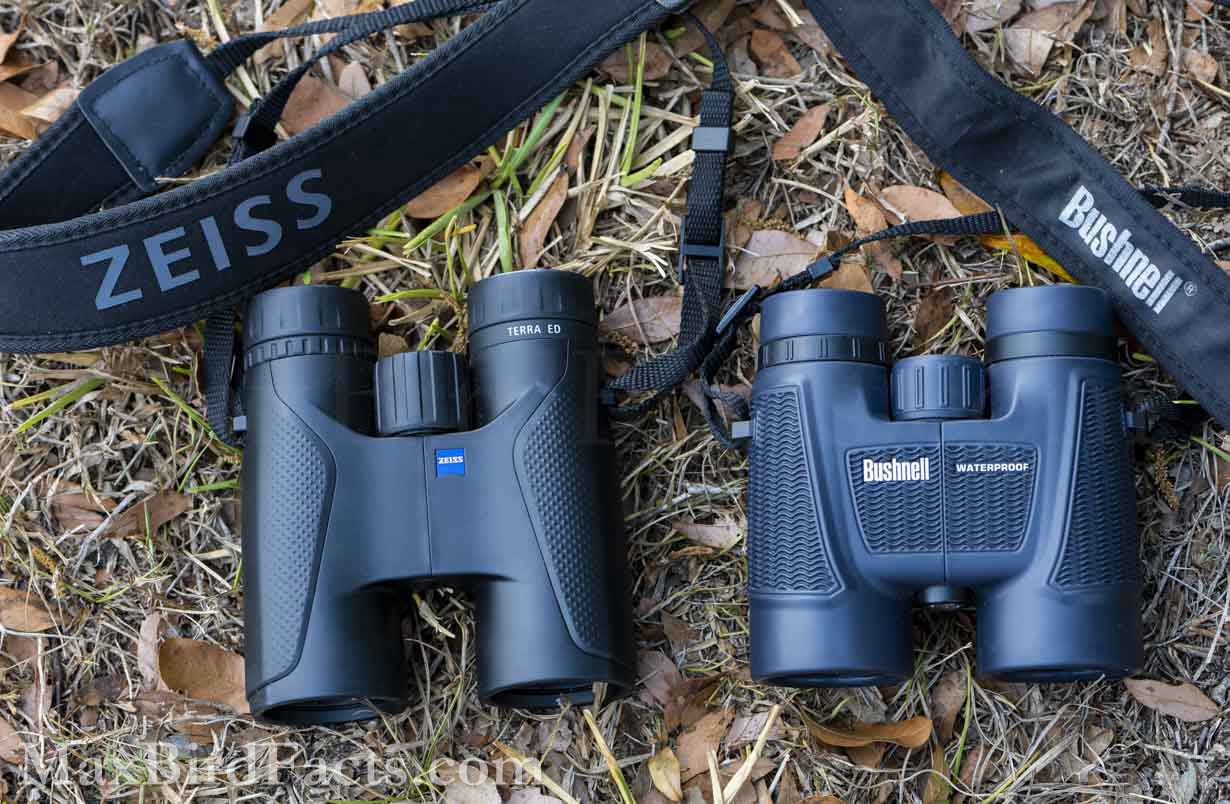
So, what makes a $500 pair of Zeiss binoculars considerably better than a $100 pair of Bushnells? That’s what I hope to explain in this article.
But before we get too far into it, I want to stress that the Bushnell H2O 10x42s are my recommendation for anyone who wants to get a pair of binoculars without breaking the bank. They are a great pair of binoculars without being overly expensive and do almost everything the $500 Zeisses do, albeit with some obvious cost savings.
Justify it this way, even if you are into birding, you will probably spend the same amount of money in gas driving to all your hotspots over the next few weeks as you would on this pair of Bushnell binoculars. Trust me, using binoculars will change the way you bird.
Before we get into these two specific models, let’s quickly talk about what I personally look for in a good pair of binoculars for birding.
How To Choose Binoculars For Bird Watching
I look for three critical things in a pair of birding binoculars:
- Glass clarity
- Magnification
- Focus range and speed
The first aspect is an obvious one, glass clarity. If I can’t see the bird through the glass well, I might as well just use my camera. Both the Bushnell H2O and Zeiss Terras check this box comfortably.
Second, magnification is a must for binoculars. This is a personal preference, but I prefer ten times magnification, and I think the 10×42 size is the perfect middle ground for a lightweight but competent pair of binoculars. Again, both the Bushnell H2O and Zeiss Terras meet this requirement.
Finally, and this might only seem important once you use binoculars for a while, the speed and range in which the binoculars can focus. Switching from a raptor in flight a ways off to a warbler in the grass at your feet is vital when birding during migration. This was my deciding factor when I moved from the Bushnells to the Zeiss.
The Bushnell H20 10x42s can focus as close as 7 feet (2.13 meters). However, the Zeiss Terra ED 10x42s can focus within 4 feet (1.22 meters).
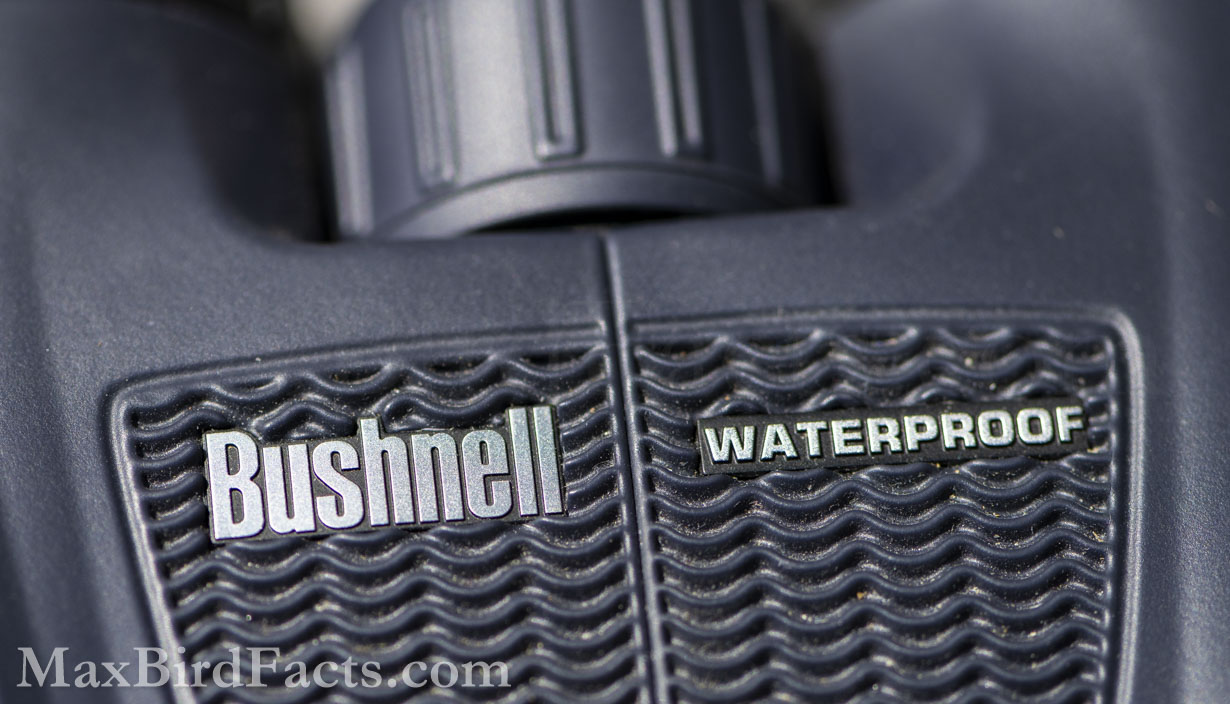
Further, the focus wheel on the Zeiss can adjust the focal distance nearly twice as quickly as the Bushnells. So, if the difference of 3 feet isn’t a big deal, moving the focus from that flying raptor to the bouncing warbler will take nearly half the time on the Zeiss binoculars than the Bushnells should.
I should note these three criteria can be used to pick out any pair of binoculars. The Bushnell H2O 10×42 and Zeiss Terra ED 10×42 are two pairs I personally own and can strongly recommend after hundreds of hours of birding with each.
I should also state that I am in no way sponsored by any company in this article. Everything here is gear I’ve purchased with my own money and use every time I go out birding, and I have found them very dependable items.
Now that we have the criteria for what makes a good pair of birding binoculars let’s look at the contenders.
$100 Bushnell H2O 10×42 – Best Binoculars For Beginners
Amazon.com: Bushnell H2O 10×42 Roof Prism Binoculars

The Bushnell H2O 10x42s are my go-to pair of binoculars to get people started. I would even go as far as to say the Bushnell H2O 10×42 binoculars are the best budget binoculars for bird watching.
The retail MSRP for these binoculars is $165.99, but I bought my first pair at $99.57 and the second at $90.94. They seem to constantly float around the $100 range, which is a perfect starting point for most new birders.
Weighing just 668 grams, or 1.47 pounds, these binoculars are comfortable for a full day of birding. However, they could have spent more time designing the neck strap.
What comes on the binoculars from Bushnell leaves a bit to be desired. The thin material of the central pad doesn’t do much to cushion the binoculars, so I recommend getting either a harness or a new neck strap.
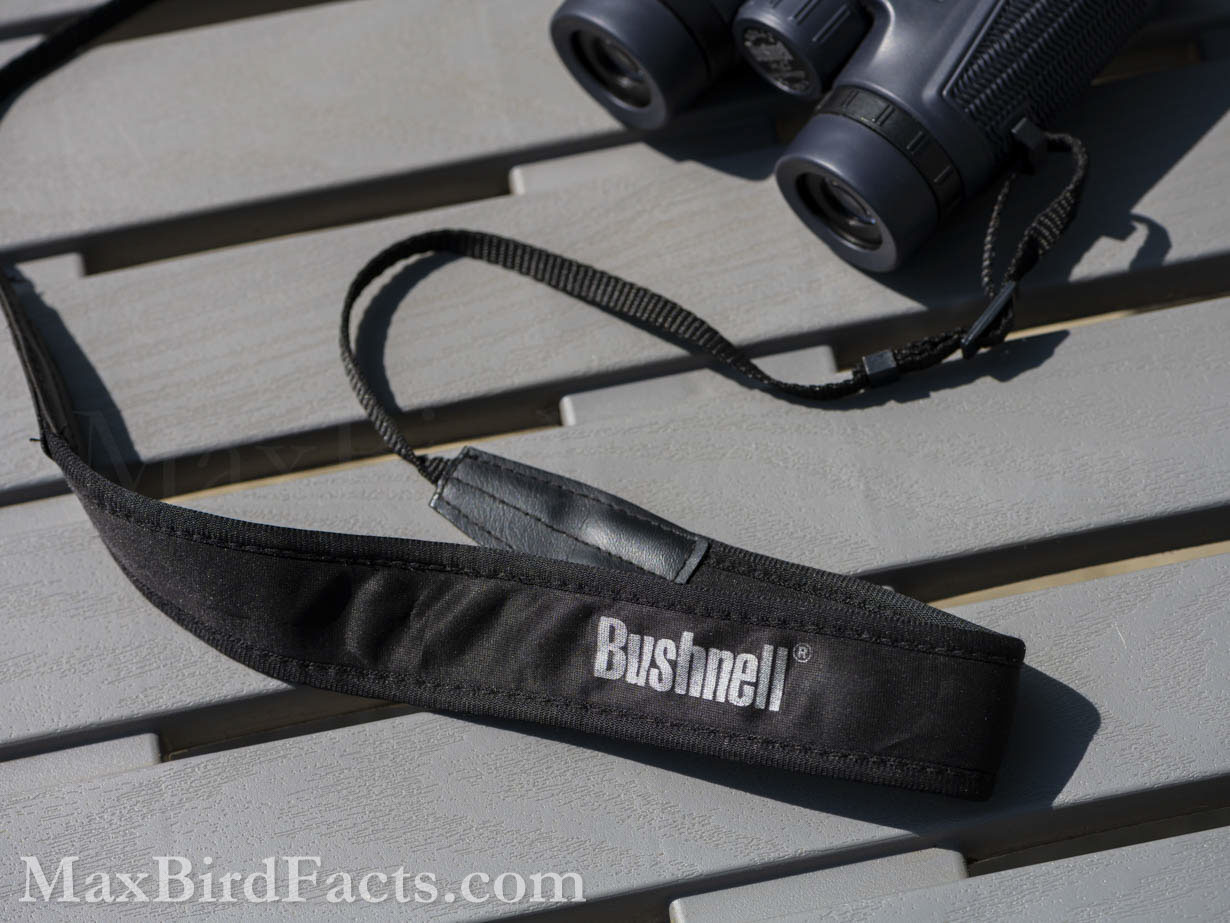
I would recommend the OP/TECH USA Pro Loop Strap. I’ve used one of these as a camera strap for the past ten years, and it is exceptionally comfortable.
This year, I purchased a new strap to replace my original. This change was mainly for a fresher, cleaner appearance, but the design of the new Pro Loop Strap has improved noticeably from my original.
Its thicker neoprene pad is very comfortable, and the rubber traction points are more precisely located. Attaching the strap to the camera is also foolproof by simply looping the paracord through the camera body’s anchor points. If you’re in the market for a new camera strap or to replace the strap on your Bushnell binoculars, I would strongly recommend this.

Amazon.com: OP/TECH USA Pro Loop Strap

Besides the neck strap, the Bushnell H2Os are solid, inexpensive binoculars.
The H2Os have a field of view of 305 feet at 1000 yards. This range seems to be the industry standard for most 10×42 binoculars.
As I said in the previous section, the Bushnell H2Os can focus up to 7 feet or 2.13 meters. This distance is perfectly adequate to use while watching birds on my feeder. However, the focus ring on these binoculars could be better.
When I adjust the focus on my binoculars, I typically use my right index finger to pull from the middle of the ring down to the right tube. The problem with these binos is they take a while to shift focus if the distance is substantial.
Still, even though this is a bit of a problem to me, for $100, Bushnell had to cut costs somewhere, and it looks like part of it was the focus speed. That said, this is more of a personal preference and quibble I have with these binoculars. Once you focus the H2Os on your subject, the crystal clear glass makes up for the time.
One thing that pushed me to get the Bushnell H2Os over other brands like Vortex is their glass quality. For only being $100, the H2Os have insanely clean glass. This is vital for light transmission and precisely looking at your subject.
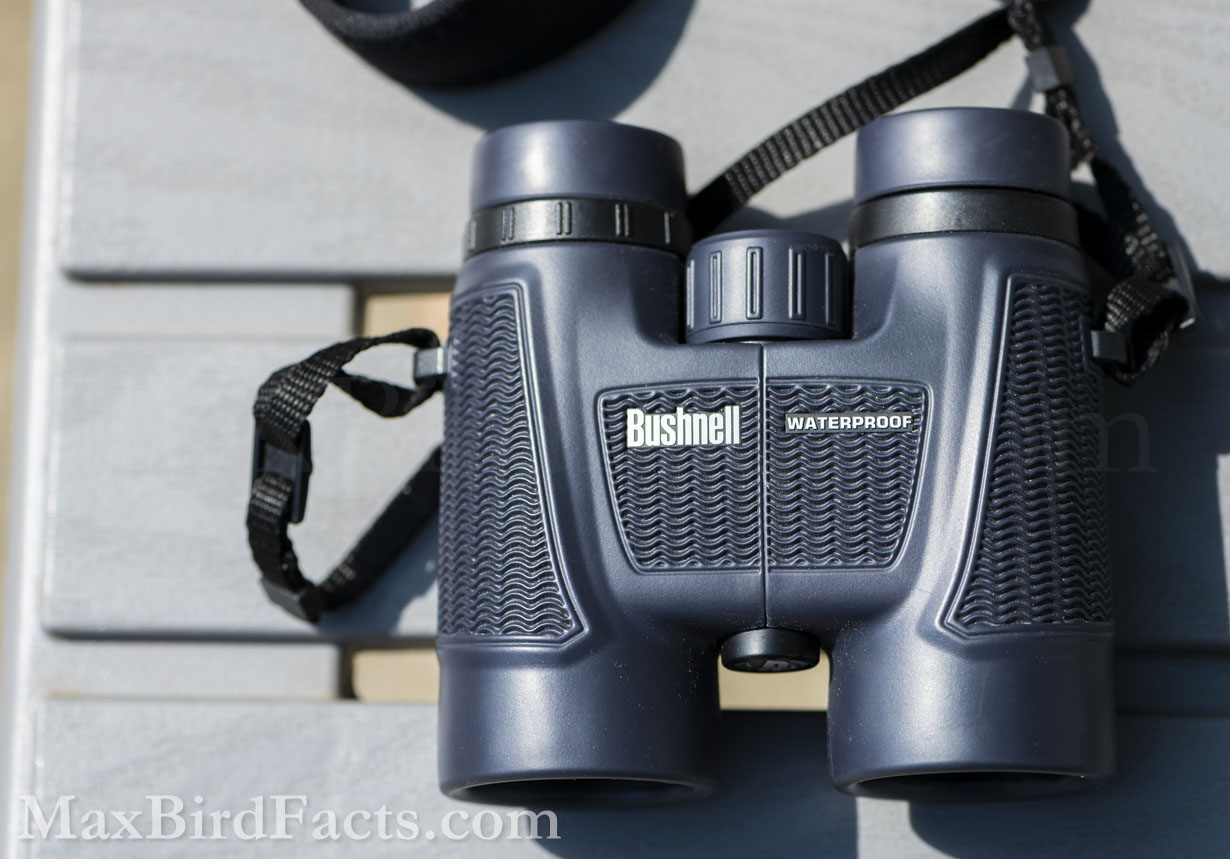
They are fully waterproof, with an IPX7 rating (can survive being submerged 1 meter for 30 minutes). In addition, its textured, rubberized finish is effortless to hold onto, even with sweaty hands or birding in a hurricane.
During Hurricane Ian in 2022, my girlfriend and I went birding after the main brunt of the storm had passed. These binoculars stood up perfectly to the wind and rain for hours, looking for lost seabirds.
Even though the Bushnell H2Os have some drawbacks with the camera strap and focus ring, these shouldn’t deter you from trying them out. The truth is, I used these binoculars for almost a year and a half before finally caving and getting the Zeiss Terra EDs.
The strap is easily replaced, and the focus ring is more of a nitpick than a serious problem.
Overall, the Bushnell H20 10x42s are the best binoculars for beginners. If you are just starting birding and are questioning whether or not you should get a pair of binoculars, buy a pair of Bushnell H20 10x42s.
$500 Zeiss Terra ED 10×42 – The Best Binoculars For Bird Watching
Amazon.com: Zeiss Terra ED 10×42 Binoculars

The Zeiss Terra ED 10×42 binoculars might be the best in their price range. I purchased my pair in late October 2022 for $499.99, and I couldn’t be more satisfied.
It is hard to fully explain the difference between the Bushnells and Zeisses without putting them in your hands. Even though the Terras weigh 757 grams or 1.67 pounds, almost a quarter pound more than the H2Os, they feel lighter in hand and around the neck.
I think a lot of this has to do with the overall design of the Terras. These binoculars have a slightly thinner and longer profile that helps to distribute their weight better than the H2Os.
The surface on these binos also is the perfect blend of smooth rubberized and slightly textured hand holds. Even though the texturing on the Terras might not look as well defined as the H2Os, I definitely prefer the more subtle design Zeiss created.
Alongside this, the Terra EDs come with a spectacular neck strap. Zeiss obviously designed this strap to stay on their binoculars and give a birder the comfort they deserve.
Its thick neoprene pad cushions your neck while hiking with it. The thin, flexible nylon straps also provide the right amount of mobility and retention while walking with these binos. Since purchasing these, I haven’t once thought of replacing the neck strap.
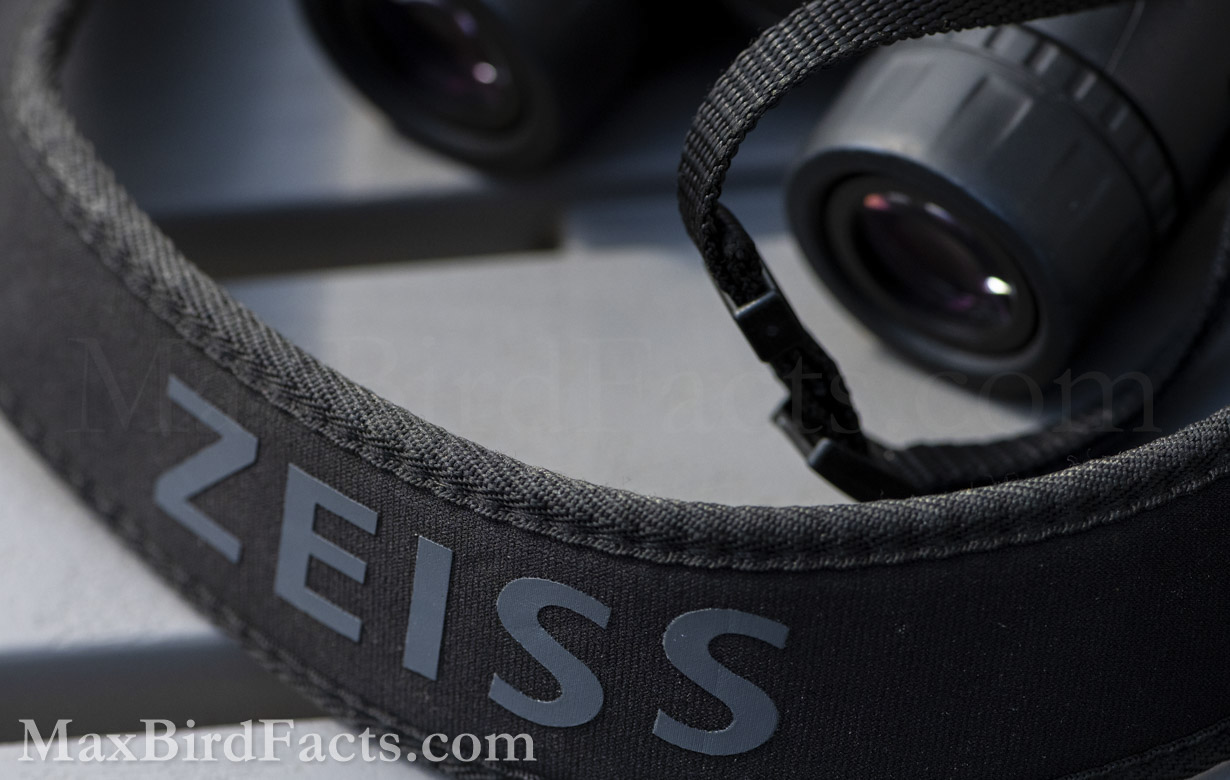
The Zeiss Terra EDs have a slightly better field of view of 330 feet at 1000 yards. This is only a 25-foot difference from the Bushnell H2Os, but the Terra’s better field of view is strikingly noticeable at closer distances.
As I mentioned above, the Zeisses can focus within 4 feet or 1.22 meters. This is perfect for me since I have a window feeder at my desk, and the seven-foot range of the Bushnells is too far to focus if a Tufted Titmouse lands on it. This short-range also means you can get spectacular views of insects and wildflowers too.
The glass clarity of the Terras is staggering. The first thing I noticed when borrowing my dad’s binoculars was how much brighter and more precise the view was. Zeiss is exceptionally well known for their glass quality, and the Terra EDs are no exception.
This crystal clear glass also helps give the Terras 88% light transmission. Unfortunately, I couldn’t find an exact number for the Bushnell H2O’s light transmission, but it is noticeably lower.
One of the primary reasons you want ample light transmission in your binoculars is to try and squeeze every ounce of detail out of your subject, regardless if you are in the shade, birding past sunset, or in the predawn gloom.
With my original Bushnells, once the sun started to dip, they became next to useless. However, my Zeisses can keep light coming in well into dusk, and fail around the point where there is barely enough sunlight left to see without the binocs.
The lens covers on the Zeiss are much better designed than the basic caps provided by Bushnell. However, I’ve removed the caps from both binoculars since they always seem to flop in the way when I’m trying to spot a bird.
Like the H2Os, the Terras are waterproof. Zeiss states that the Terra ED 10×42 binoculars are water resistant to 100 bar, equal to 100 atmospheres. This is on par with some of the highest-end dive watches, so some summer rain should be no problem for the Terras.
Overall, every birder should strive for the Zeiss Terra ED 10×42 binoculars.

There could possibly be better binoculars out there, but still, I’m hard-pressed to purchase another pair of binos after the spectacular performance from my Terras.
I think they embody precisely what birding binoculars should be. They are reasonably lightweight, have spectacular glass clarity, are fully waterproof, have rapid focus adjustments, and come with all the attachments you’ll want or need right out of the box.
Again, if you want to take your birding to the next level, you should really consider a pair of Zeiss binoculars.
Is Zeiss 5x Better Than The Bushnell???
In short, yes. I think the Zeiss Terra EDs are five times better than the Bushnell H2Os.
Yeah, the price tag of $499.99 is hard to swallow, but having a solid, dependable piece of equipment is well worth it. This is even more tenable, considering I’ve used my Terras daily since purchasing them.
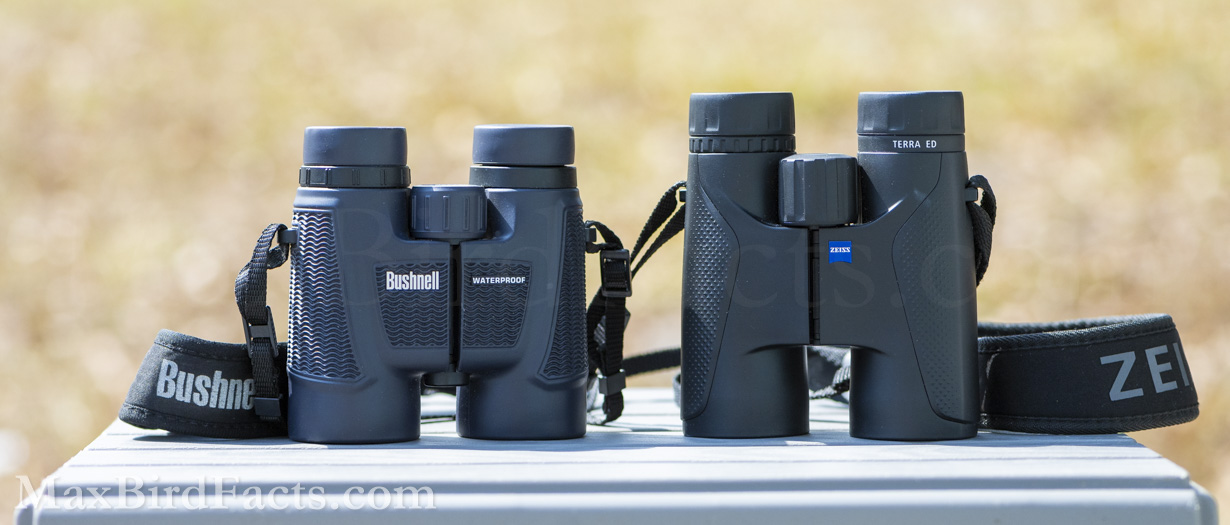
Now, I will say that just because something is more expensive doesn’t necessarily make it superior. For example, I’ve looked through a few pairs of Swarovski 10×42 binoculars, and I was impressed until I found out they cost over $2,000.
These were not twenty times better than the Bushnells or four times better than my Zeisses. I could do many things with two thousand dollars, and a pair of binoculars isn’t on that list.
However, back to the Bushnells and Zeisses, I think the overall package of the Terras easily justifies their cost. The clearer glass, better low light function, quick focus ring, much more comfortable strap, and overall finish of the Zeiss Terra EDs makes them worth every penny. In my opinion, each of these factors adds up to make the Zeisses an overall better pair of binoculars.
The Bushnell H2Os are the perfect gateway to your next step as a birder. They’re lightweight, comfortable to carry and have very clear glass for their price. Of course, they could have a better neck strap and a snappier focus ring, but I think this is understandable for one-fifth the cost of the Terras.
So again, to hammer the point of this article home, the Zeiss Terra ED 10×42 binoculars are five times better than the Bushnell H2O 10×42 binoculars. The H2Os are a great starting point, but the Terra EDs are what you should strive for.
Are Binoculars Better Than A Camera?
So, why would you want binoculars around your neck if you’re already lugging around a camera? The honest answer is these two objects serve two very different purposes.
A camera is perfect for capturing a moment in time for you to look back on. Whether that moment was a wedding, anniversary, accomplishment, or vacation, you usually want to cherish and share it.
Cameras are also fantastic for wildlife and birds most of all. Capturing minute details in a bird’s feathers or the moment a raptor tears a fish out of the water is both challenging but exhilarating when it works out.
However, a camera’s drawbacks are its narrow focal range and tight field of view.
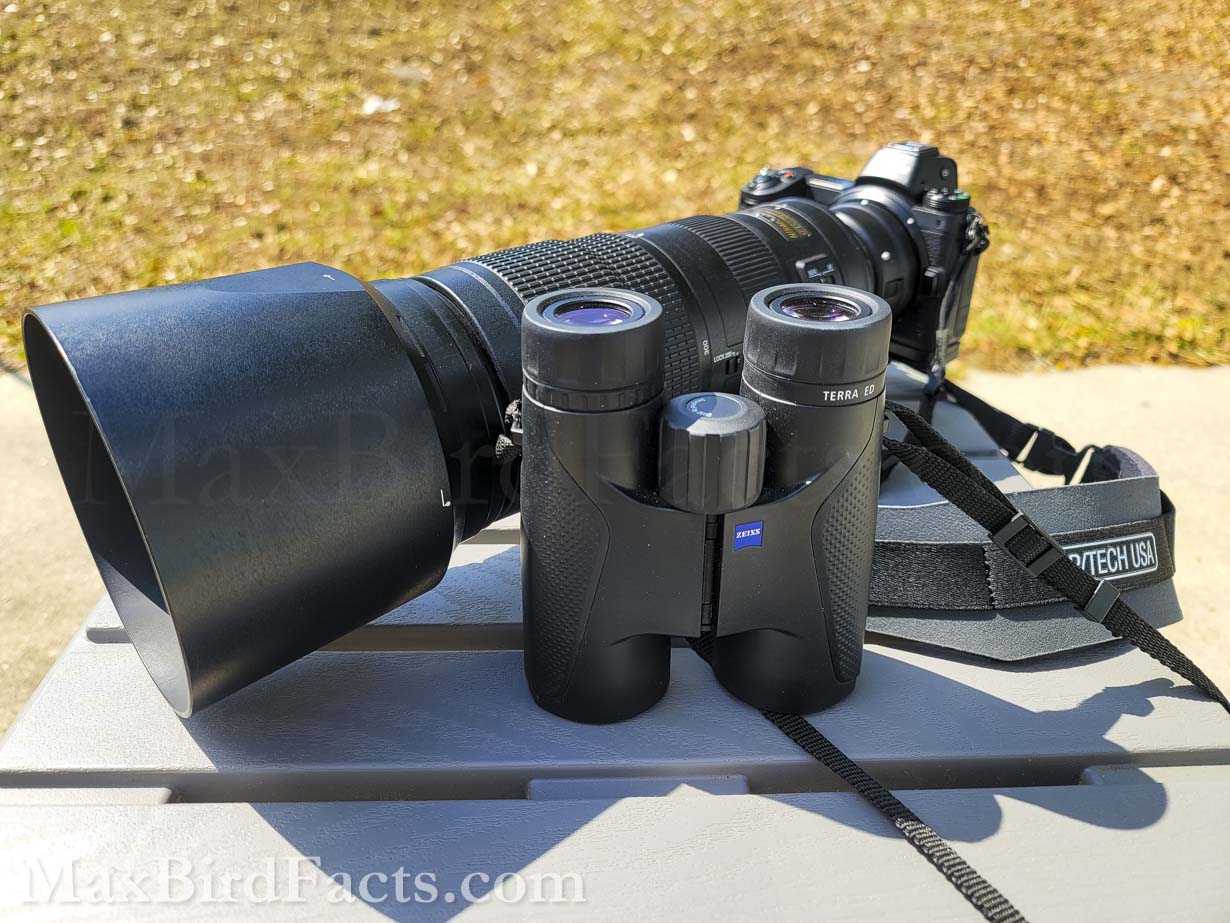
The numbers used to describe a pair of binoculars are its magnification followed by the diameter of its objective (front) lens. So, my Zeiss 10x42s have a ten-times magnification and 42mm objective lenses. The diameter of the lens typically equates to its field of view; the larger the diameter, the larger the field of view and more light that can come through the binoculars.
With my current setup as the example, my Nikkor 200-500 f/5.6-32 lens has about half the field of view compared to either the Bushnell or Zeiss binoculars. This isn’t necessarily because of a smaller objective lens on the camera; it has to do with the length the light travels through the camera before the image is captured on the sensor.
The millimeter measurement for a camera’s lens can be translated into its optical zoom value by dividing it by 50. So, my 500mm lens is equal to 10 times magnification. Using these numbers, my camera is roughly equivalent to a 10×20 pair of binoculars.
One of the most frustrating interactions you can have with a bird is when it is hiding in thick grass or a bush. The camera’s autofocus will hunt around the bird and rarely catch the subject, so you must use manual focus. The area the camera keeps in focus is also very tight; if you focus just in front of or behind your subject, it will be noticeably soft and isn’t worth keeping.
Another big drawback to using a camera is cost and weight. For example, the camera body of the Nikon Z7 retails for a few dollars less than $3,000, and the lens is another $1,500. Obviously, there are less expensive options for both camera body and lens, but this setup has been my favorite for a few years now.

Amazon.com: Nikon 200-500 mm/F 5.6 AF-S NIKKOR E ED VR Lenses

My current setup weighs in at 3384 grams or 7.46 pounds. This isn’t extremely heavy for a quick outing, but carrying it on a 10-mile hike isn’t the most pleasurable. Compare this to the weight of my Zeiss binoculars at only 757 grams, or 1.67 pounds.
Keep in mind the memory cards and batteries you need to keep on you for the camera. Forgetting a spare battery and having a half-dead one in your camera is very stressful; trust me, I’ve done it more than once.
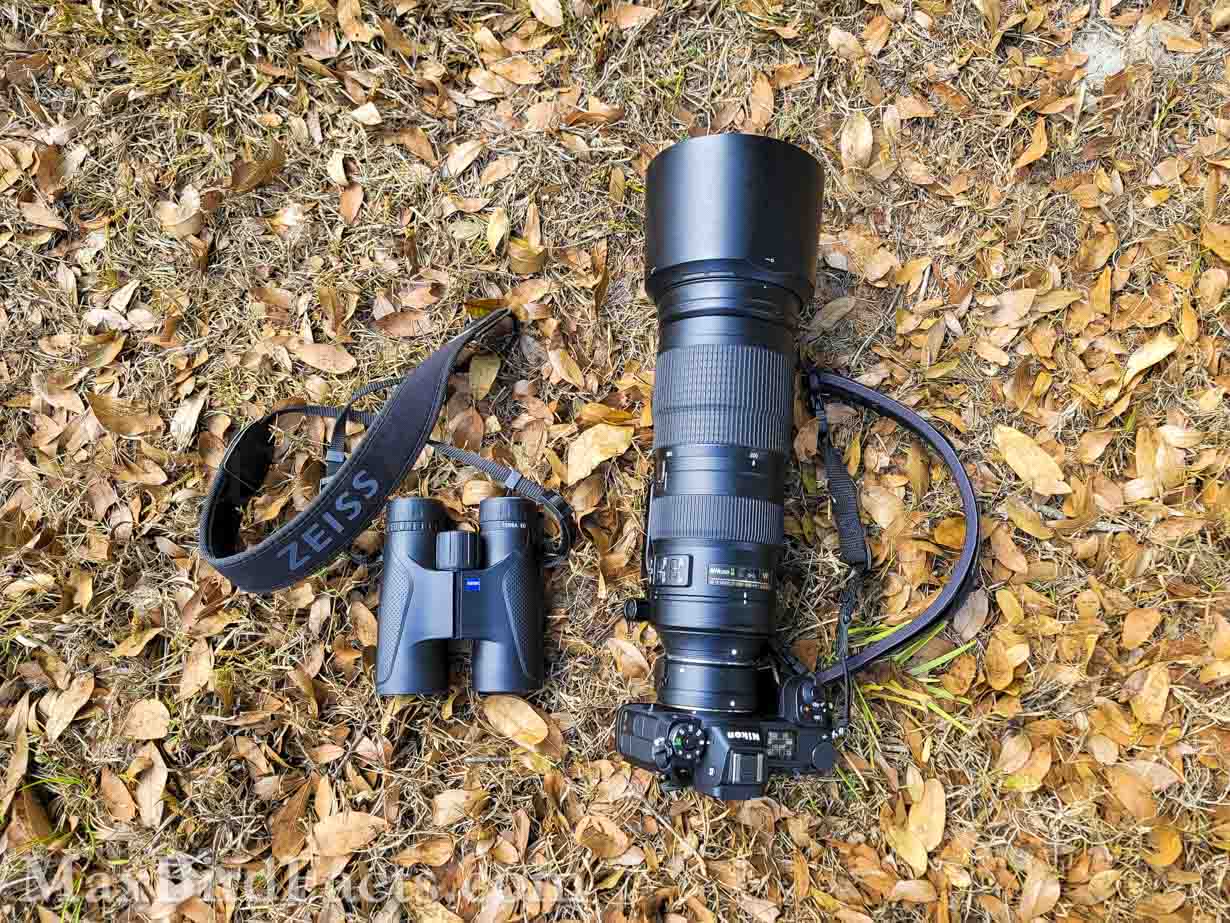
The same problem arises if you leave a spare card at home. And these batteries and cards don’t come cheap. Memory cards for higher-end cameras average about $1 per gigabyte, so a 120GB card will cost around $120, and batteries start at roughly $75.
All in for a good camera body, lens, two spare batteries, and two 120GB cards will cost just shy of $5,000 before tax. Now that $500 pair of Zeiss Terra ED 10×42 binoculars doesn’t seem so expensive!
Still, having the ability to photograph birds conducting their natural behaviors makes this cost well worth it to me. However, quickly bringing up my binoculars to see what bird is perched on a wire well before my camera could focus is a huge advantage.
So, the loss of capturing an image comes with the benefit of cost and weight savings in your binoculars.
And this is why I carry both binoculars and a camera.
Lugging around a 7.5-pound camera makes carrying a 1.7-pound pair of binoculars around my neck a breeze.
I can very quickly spot a subject through my binoculars, and if it is interesting enough, I can capture a few images before it flies away. I’ve found that doing this saves me a ton of time, not having to sort through and edit dozens of photos of more common birds when searching for a rarity.
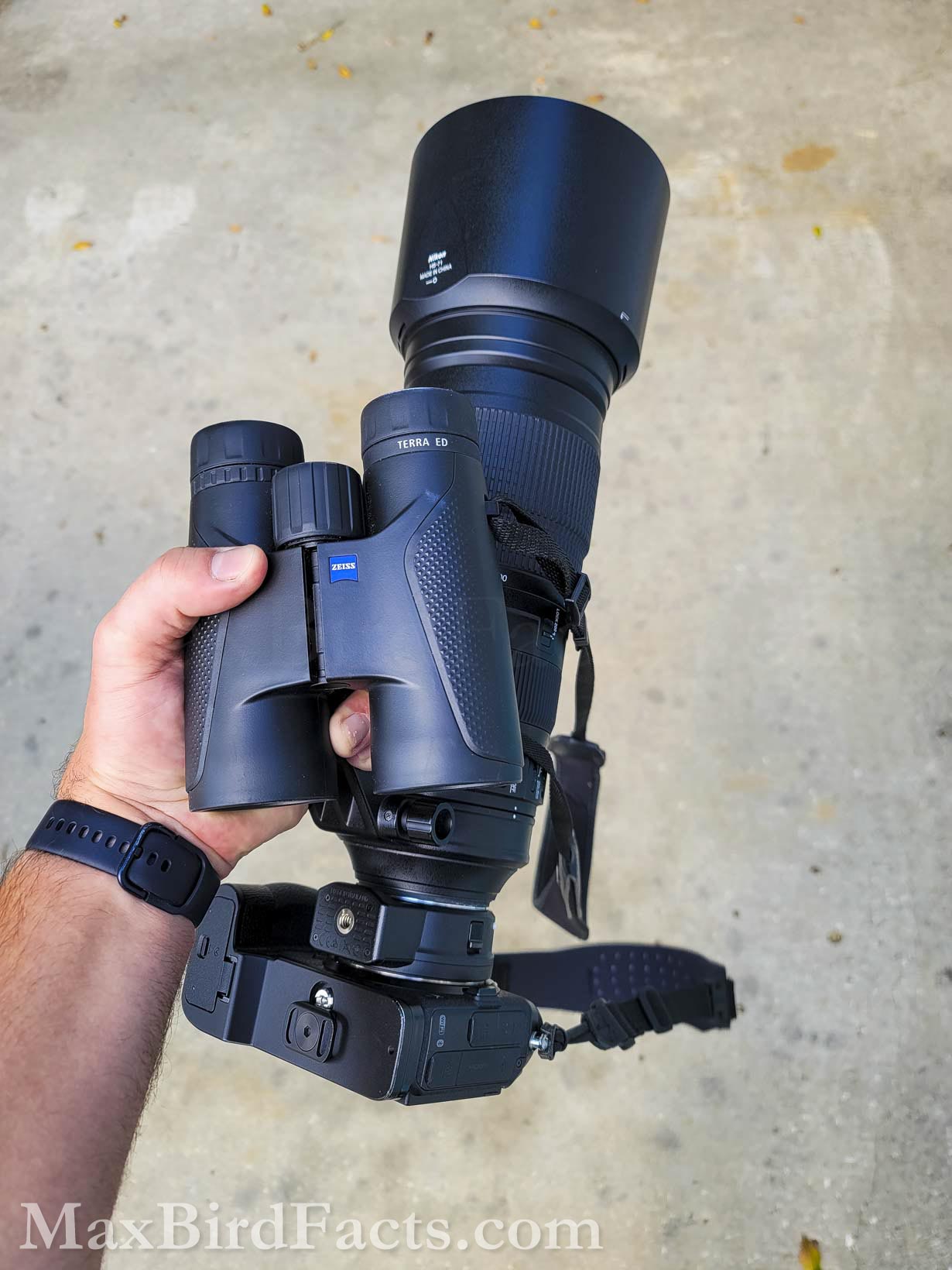
Now We Know $500 Binoculars Are Better Than $100 Binoculars!
Binoculars should be a part of any birder’s kit.
If you can’t afford a camera to photograph during your outings or simply aren’t interested in photography, I strongly urge you to take the leap and buy a pair of binoculars.
Since getting my first pair of Bushnell H2Os in college, my binoculars don’t stray too far from my side, though they have changed from Bushnell to Zeiss. But I think this is each of these binoculars’ purpose.
The Bushnells are a much more accessible option to someone unsure if they will be birding every weekend or simply can’t swing more than a hundred dollars for binoculars. They are an affordable option to make a new birder’s experience much better in the field and get them hooked.
The Zeiss is geared towards someone who treats birding as more than a weekend hobby. The person who carries a pair of Zeiss binoculars is the same person who is out in the forest or marsh looking for birds before sunrise and pulls into their drive well after dark.
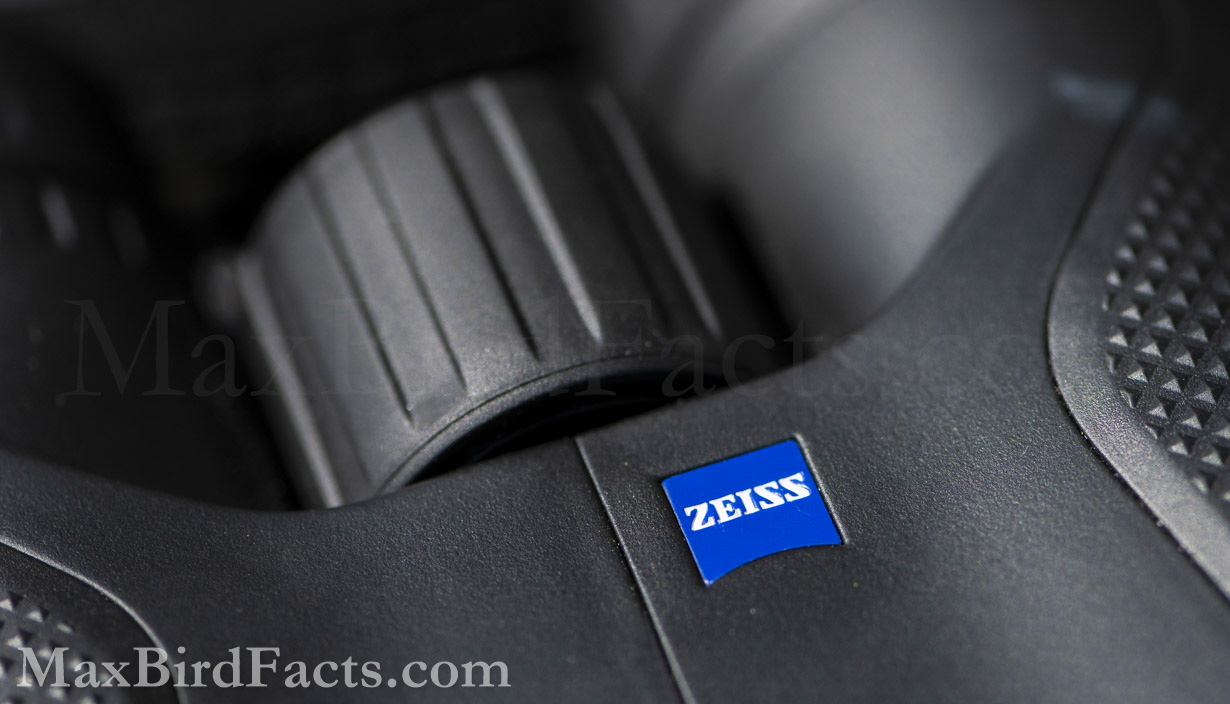
If you are just starting to get into birding, or your budget is a little tight, there is absolutely nothing wrong with the $100 pair of Bushnell H2O 10x42s. They are rugged, dependable binoculars that punch way above their weight. I used mine for a year and a half before making the switch, and I still recommend them heavily.
However, if you can see the $500 price tag of the Zeiss Terra ED 10x42s without flinching, you should jump on them. Their immaculate clarity, speedy focus, and perfectly designed neck strap and lens caps push it well outside the reach of the Bushnells.
The lower cost of the Bushnells will allow you to get the magnification and features of a high-quality pair of binoculars without breaking the budget. Still, the cost difference to the Zeiss is well worth it in my eyes.
Let me know what you think. Are the Zeiss Terra EDs worth five times as much as the Bushnell H2Os?
I hope you enjoyed this article. I know it is a bit of a change from my typical avian articles, but I wanted to share some knowledge and thoughts to hopefully help you become a better birder!
If you have ideas or suggestions for topics you would like me to write about in the future, feel free to leave a comment below or shoot me an email!
Get Outside & Happy Birding
Max
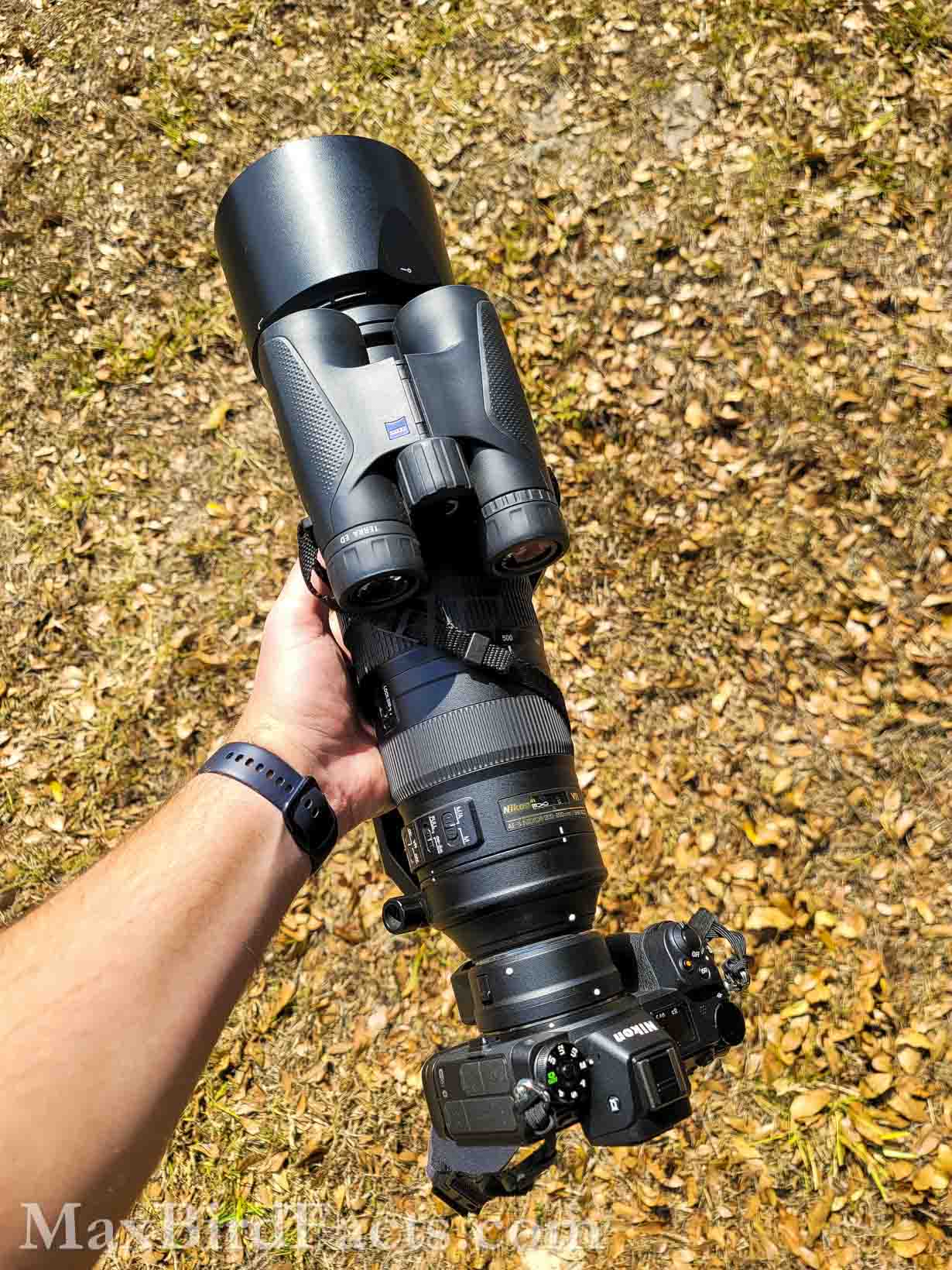
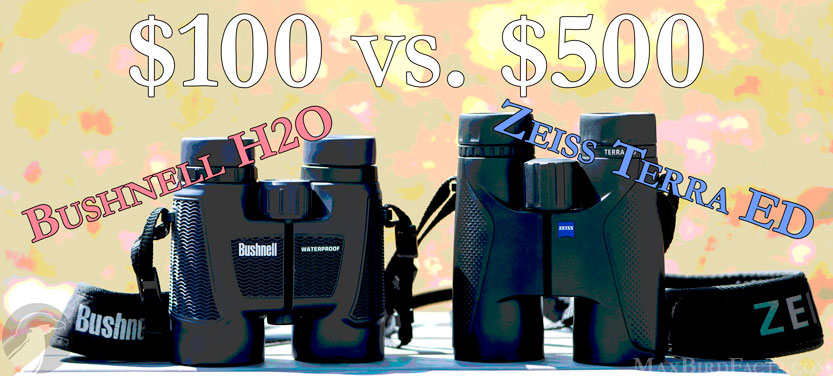
Pingback: 101 Presents for Birders – Ultimate Gifts for Bird Lovers – Welcome to MaxBirdFacts.com!!!